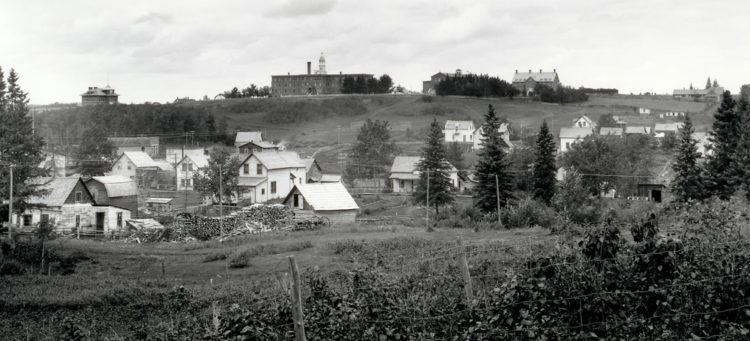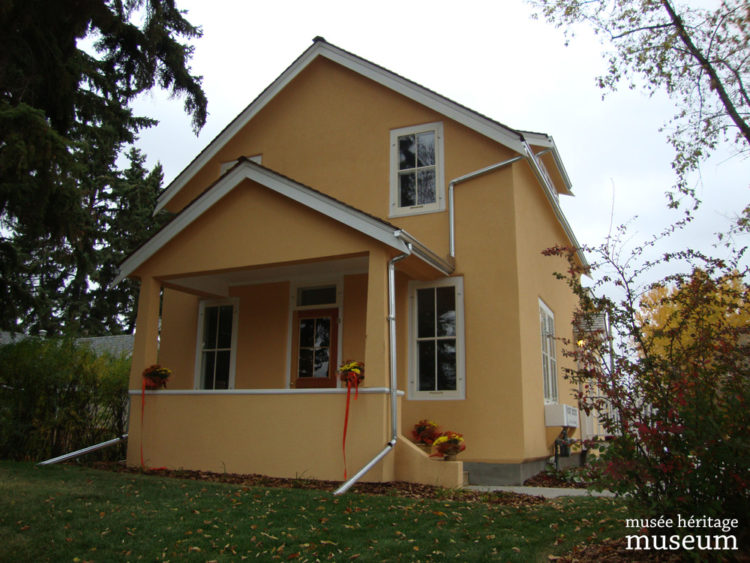
Then & Now
Juneau House: A Mission Avenue Monument stands as a timeless local attraction
January, 2020
At the core of every city is a structure which remains firmly rooted as the community grows around it. London has Westminster Abbey, Paris has Notre-Dame, and St. Albert has Juneau House. While not as famous or grandiose as its European counterparts, Juneau House, located at 9 Mission Avenue—the city’s oldest residential road—is surely important to the history and development of St. Albert.
Late 1800s
Completed in 1890, Juneau House stands proudly
as St. Albert’s oldest residence. Its construction
was associated with the original town planning and surveying undertaken
by the Roman Catholic Diocese when the area’s
farmland was first subdivided into
river lots for the establishment of the
community. The house is named after its first owners—brothers Edmund and
Frank Juneau. Originally from Quebec, they came to St. Albert from Kamloops,
B.C., in the mid-1870s. Edmund married a Blackfoot woman from Montana named
Marie Beauchemin and worked as a farmer and schoolboard trustee. Frank was a
carpenter by trade, as well as a trader who
frequently traveled to spots like Lac La Biche, Athabasca Landing and Victoria
Settlement. At the turn of the century, Frank was unanimously elected by
all voting members of the community to the
position of “Village Overseer,” which he served as until his death in
1902.
1900s–1930s
The same year Frank Juneau died; Dr. J. Arthur
Giroux, the home’s most storied owner, moved from Quebec to St. Albert where he
swiftly became the town’s first community
health officer. In 1903, Giroux married a Quebecois nurse named Alice Morin and that same year the newlyweds
moved into Juneau House where they would convert the front room into the base
for their medical practice. With patients also in Villeneuve, Riviere Qui
Barre, Morinville, and Namao, Giroux would
often make house calls via
horseback or dogsled.
In 1913, Giroux was elected as St. Albert’s sixth mayor, succeeding Leon Levasseur, which he served as until 1918. When Giroux and Morin weren’t governing the town, or aiding the ill, they were instrumental in organizing local entertainment. Giroux, a violinist, and Morin, a pianist, strung together a community band, which performed concerts and held dances at local functions. At Juneau House, they would host musicals, plays, as well as piano lessons which Morin instructed. Unfortunately, it was not long before cheers turned into tears. Giroux died suddenly in his home in 1938. While accounts of his death vary, some believe that he took his own life. Future owners and visitors of the home have reported strange sensations, sounds, and smells—most frequently in a small bedroom upstairs which overlooks Mission Avenue.
1950s–1990s
In 1955, the home’s final residential owners moved in. While maybe not as prominent in the history and development of St. Albert as the Juneaus or the Girouxs, the Roberts did make several much-needed improvements to the house. Up until the 1950s, the home’s kitchen had been located outdoors. Therefore, the Roberts figured it was time to construct one inside the home. They also installed plumbing and added a porch to the west end of the house facing Mission Avenue. On the east end of the house, they attached a barn which they had acquired from up the hill as a makeshift addition. The Roberts enjoyed these luxuries until the 1990s when the city purchased the house from them, turning it into a brief home for Arts and Heritage.
2000s

In 2004, the city reached out to the Honourable Senator Dr. Thelma J. Chalifoux, offering her the exclusive use of Juneau House for her constituency office which she happily accepted. As the first Métis woman appointed to the Senate of Canada, it was only fitting that Chalifoux would establish the Michif Cultural Institute (now Michif Cultural Connections) within Juneau House that same year. One of few Métis cultural centres in Alberta, the organization aimed to preserve, protect, and celebrate Alberta’s rich Métis history, culture, and tradition. Chalifoux passed away in 2017 at the age of 88, but the organization, now directed by her daughter, Sharon Morin, proudly continues her legacy by offering programs, facilitating workshops, displaying artifacts, and providing access to a variety of library and archival items.
2010s–Today
After the city discovered that the house was slowly sinking, it underwent a major, year-long restoration project in 2015. Still resting on its original wooden foundation, the first phase of the project consisted of redoing the basement and pouring a concrete foundation. This was followed by window repairs, a roof replacement, an accessible bathroom installation, and a full kitchen reconstruction which involved replacing the Roberts’ barn addition with a more modern one. The veranda above the porch was rebuilt and a peach-coloured stucco siding was applied to the home’s exterior in order to match the original shade of the house. In addition, the property was landscaped, new sidewalks were added, and a wheelchair ramp was installed. In a sense, “Juneau House has come full circle in the community,” says Michif Cultural Connections office manager, Joshua Morin. Not only has it been restored to its former physical glory, it is also bringing back the culture and tradition of the Métis people who first settled in St. Albert












